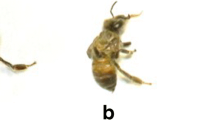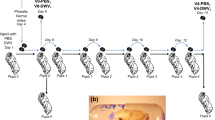Abstract
Mites in the genus Tropilaelaps (Acari: Laelapidae) are ectoparasites of the brood of honey bees (Apis spp.). Different Tropilaelaps subspecies were originally described from Apis dorsata, but a host switch occurred to the Western honey bee, Apis mellifera, for which infestations can rapidly lead to colony death. Tropilaelaps is hence considered more dangerous to A. mellifera than the parasitic mite Varroa destructor. Honey bees are also infected by many different viruses, some of them associated with and vectored by V. destructor. In recent years, deformed wing virus (DWV) has become the most prevalent virus infection in honey bees associated with V. destructor. DWV is distributed world-wide, and found wherever the Varroa mite is found, although low levels of the virus can also be found in Varroa free colonies. The Varroa mite transmits viral particles when feeding on the haemolymph of pupae or adult bees. Both the Tropilaelaps mite and the Varroa mite feed on honey bee brood, but no observations of DWV in Tropilaelaps have so far been reported. In this study, quantitative real-time RT-PCR was used to show the presence of DWV in infested brood and Tropilaelaps mercedesae mites collected in China, and to demonstrate a close quantitative association between mite-infested pupae of A. mellifera and DWV infections. Phylogenetic analysis of the DWV sequences recovered from matching pupae and mites revealed considerable DWV sequence heterogeneity and polymorphism. These polymorphisms appeared to be associated with the individual brood cell, rather than with a particular host.


Similar content being viewed by others
References
Anderson DL, Morgan MJ (2007) Genetic and morphological variation of bee-parasitic Tropilaelaps mites (Acari: Laelapidae): new and re-defined species. Exp Appl Acarol 43:1–24
Bakonyi T, Grabensteiner E, Kolodziejek J, Rusvai M, Topolska G, Ritter W, Nowotny N (2002) Phylogenetic analysis of acute bee paralysis virus strains. Appl Environ Microbiol 68:6446–6450
Ball B (1989) Varroa jacobsoni as a virus vector. Present status of varroatosis in Europe and progress in the varroa mite control. Commission of the European Communities, pp 177–181
Berenyi O, Bakonyi T, Derakhshifar I, Koglberger H, Topolska G, Ritter W, Pechhacker H, Nowotny N (2007) Phylogenetic analysis of deformed wing virus genotypes from diverse geographic origins indicates recent global distribution of the virus. Appl Environ Microbiol 73:3605–3611
Blanchard P, Olivier V, Iscache A-L, Celle O, Schurr F, Lallemand P, Ribiere M (2008) Improvement of RT-PCR detection of chronic bee paralysis virus (CBPV) required by the description of genomic variability in French CBPV isolates. J Invertebr Pathol 97:182–185
Boecking O, Rath W, Drescher W (1992) Apis mellifera removes Varroa jacobsoni and Tropilaelaps clareae from sealed brood cells in the tropics. Am Bee J 132:732–734
Bowen-Walker PL, Martin SJ, Gunn A (1999) The transmission of deformed wing virus between honeybees (Apis mellifera L.) by the ectoparasitic mite Varroa jacobsoni Oud. J Invertebr Pathol 73:101–106
Burgett M, Akratanakul P (1985) Tropilaelaps clareae, the little known honey bee brood mite. Am Bee J 125:112–114
Camphor ESW, Hashmi AA, Ritter W, Bowen ID (2005) Seasonal changes in mite (Tropilaelaps clareae) and honeybee (Apis mellifera) populations in Apistan treated and untreated colonies. Apiacta 40:36–44
Chen YP, Evans JD (2007) Historical presence of Israeli acute paralysis virus in the United States. Am Bee J 147:1027–1028
Chen YP, Pettis J, Evans J, Kramer M, Feldlaufer M (2004) Transmission of Kashmir bee virus by the ectoparasitic mite Varroa destructor. Apidologie 35:441–448
Chen YP, Higgins JA, Feldlaufer MF (2005) Quantitative real-time reverse transcription-PCR analysis of deformed wing virus infection in the honeybee (Apis mellifera L.). Appl Environ Microbiol 71:436–441
Chen YP, Evans JD, Feldlaufer MF (2006) Horizontal and vertical transmission of viruses in the honey bee, Apis mellifera. J Invertebr Pathol 92:152–159
Dainat B, Ken T, Berthoud H, Neumann P (2008) The ectoparasitic mite Tropilaelaps mercedesae (Acari, Laelapidae) as a vector of honeybee viruses. Insect Soc 27:1–4 (online first)
De Jong D, Morse RA, Eickwort GC (1982) Mite pests of honey bees. Ann Rev Entomol 27:229–252
Delfinado MD, Baker EW (1963) Tropilaelaps, a new genus of mite from the Philippines (Laelaptidae, (s. lat.): Acarina). Zoology 44:53–56
de Miranda JR, Fries I (2008) Venereal and vertical transmission of deformed wing virus in honeybees (Apis mellifera L.). J Invertebr Pathol 98:184–189
de Miranda JR, Drebot M, Tyler S, Shen M, Cameron CE, Stoltz DB, Camazine SM (2004) Complete nucleotide sequence of Kashmir bee virus and comparison with acute bee paralysis virus. J Gen Virol 85:2263–2270
Fujiyuki T, Takeuchi H, Ono M, Ohka S, Sasaki T, Nomoto A, Kubo T (2004) Novel insect Picorna-like virus identified in the brains of aggressive worker honeybees. J Virol 78:1093–1100
Fujiyuki T, Ohka S, Takeuchi H, Ono M, Nomoto A, Kubo T (2006) Prevalence and phylogeny of Kakugo virus, a novel insect Picorna-like virus that infects the honeybee (Apis mellifera L.), under various colony conditions. J Virol 80:11528–11538
Genersch E, Yue C, Fries I, de Miranda JR (2006) Detection of deformed wing virus, a honey bee viral pathogen, in bumble bees (Bombus terrestris and Bombus pascuorum) with wing deformities. J Invertebr Pathol 91:61–63
Grabensteiner E, Ritter W, Carter MJ, Davison S, Pechhacker H, Kolodziejek J, Boecking O, Derakhshifar I, Moosbeckhofer R, Licek E, Nowotny N (2001) Sacbrood virus of the honeybee (Apis mellifera): rapid identification and phylogenetic analysis using reverse transcription-PCR. Clin Diagn Lab Immunol 8:93–104
Hosamani RK, Rachna G, Sharma SK (2006) Bioecology and management of honeybee mite, Tropilaelaps clareae Delfinado and Baker—a review. Agr Rev 27:191–199
Hung A, Peng CYS, Shimanuki H (2000) Nucleotide sequence variations in Kashmir bee virus isolated from Apis mellifera L. and Varroa jacobsoni Oud. Apidologie 31:17–23
Jitender K, Sharma SD (2003) A note on the variability in tolerance in Apis mellifera L. colonies to the mite Tropilaelaps clareae Del. and Baker at Bajaura, Kullu, Himachal Pradesh. Pest Manag Econ Zool 11:93–96
Lanzi G, de Miranda JR, Boniotti MB, Cameron CE, Lavazza A, Capucci L, Camazine SM, Rossi C (2006) Molecular and biological characterization of deformed wing virus of honeybees (Apis mellifera L.). J Virol 80:4998–5009
Le H, Hinchcliffe M, Yu B, Trent R (2008) Computer-assisted reading of DNA sequences. Methods Mol Med 141:177–197
Maori E, Tanne E, Sela I (2007) Reciprocal sequence exchange between non-retro viruses and hosts leading to the appearance of new host phenotypes. Virology 362:342–349
Martin S, Hogarth A, Van Breda J, Perrett J (1998) A scientific note on Varroa jacobsoni Oudemans and the collapse of Apis mellifera L. colonies in the United Kingdom. Apidologie 29:369–370
Nordström S (2000) Virus infections and varroa mite infestations in honey bee colonies. PhD thesis, Department of Entomology, Swedish University of Agricultural Sciences, Uppsala
Ongus JR, Peters D, Bonmatin J-M, Bengsch E, Vlak JM, van Oers MM (2004) Complete sequence of a picorna-like virus of the genus Iflavirus replicating in the mite Varroa destructor. J Gen Virol 85:3747–3755
Rath W, Boecking O, Drescher W (1995) The phenomena of simultaneous infestation of Apis mellifera in Asia with the parasitic mites Varroa jacobsoni Oud. and Tropilaelaps clareae Delfinado & Baker. Am Bee J 135:125–127
Roossinck MJ (1997) Mechanisms of plant virus evolution. Annu Rev Phytopathol 35:191–209
Sharma OP, Kumar A, Srivastava S (1992) Behavioural reaction of Apis cerana (Hymenoptera, Apidae) to the mite, Tropilaelaps clareae (Acari, Laelapidae). Acta Entomol Bohemos 89:317–321
Sharma SD, Kashyap NP, Raj D, Sharma OP (1994) Effect of varied infestation of Tropilaelaps clareae Delfinado & Baker on brood and adult bees of Apis mellifera Linn. Indian Bee J 56:93–96
Shen M, Yang X, Cox-Foster D, Cui L (2005) The role of Varroa mites in infections of Kashmir bee virus (KBV) and deformed wing virus (DWV) in honey bees. Virology 342:141–149
Sihag RC, Singh M (1991) The honey bee mite, Tropilaelaps clareae Delfinado & Baker. Symptoms of infestation in the colonies of Apis mellifera L. Indian Bee J 53:68–72
Tamura K, Dudley J, Nei M, Kumar S (2007) MEGA4: molecular evolutionary genetics analysis (MEGA) software version 4.0. Mol Biol Evol 24:1596–1599
Tentcheva D, Gauthier L, Bagny L, Fievet J, Dainat B, Cousserans F, Colin M, Bergoin M (2006) Comparative analysis of deformed wing virus (DWV) RNA in Apis mellifera and Varroa destructor. Apidologie 37:41–50
Todd J, de Miranda J, Ball B (2007) Incidence and molecular characterization of viruses found in dying New Zealand honey bee (Apis mellifera) colonies infested with Varroa destructor. Apidologie 38:354–367
Woyke J (1987) Length of stay of the parasitic mite Tropilaelaps clareae outside sealed honeybee brood cells as a basis for its effective control. J Apic Res 26:104–109
Yang X, Cox-Foster DL (2005) Impact of an ectoparasite on the immunity and pathology of an invertebrate: evidence for host immunosuppression and viral amplification. PNAS 102:7470–7475
Yue C, Genersch E (2005) RT-PCR analysis of deformed wing virus in honeybees (Apis mellifera) and mites (Varroa destructor). J Gen Virol 86:3419–3424
Yue C, Schroder M, Gisder S, Genersch E (2007) Vertical-transmission routes for deformed wing virus of honeybees (Apis mellifera). J Gen Virol 88:2329–2336
Acknowledgements
We thank Karin Ullman at the Swedish National Veterinary Institute for the sequencing services and Dr. Anna Lundhagen for valuable comments on the manuscript. This research was funded by STREP grant #0022568 from the European Commission (Directorate E) and by travel support to IF and SW from the Chinese Academy of Agricultural Sciences.
Author information
Authors and Affiliations
Corresponding author
Rights and permissions
About this article
Cite this article
Forsgren, E., de Miranda, J.R., Isaksson, M. et al. Deformed wing virus associated with Tropilaelaps mercedesae infesting European honey bees (Apis mellifera). Exp Appl Acarol 47, 87–97 (2009). https://doi.org/10.1007/s10493-008-9204-4
Received:
Accepted:
Published:
Issue Date:
DOI: https://doi.org/10.1007/s10493-008-9204-4




